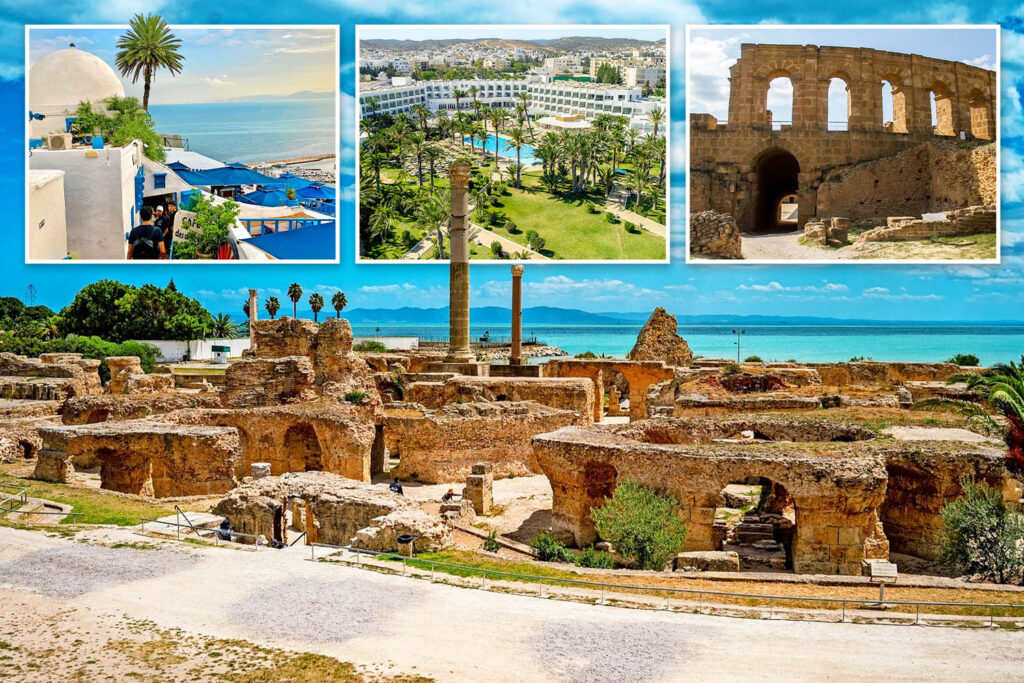WINDING my way through narrow streets, the smell of jasmine and mint tea fills the air as I pass craftsmen, locals doing their shopping and an abundance of cats.
It would have been easy to think I was in the souks of Marrakech, but I’m in Tunis, the capital of Tunisia.
While its Medina is not as chaotic as its Moroccan counterpart, the historic streets bustle with locals selling their wares as tourists like me squeeze through.
From traditional clothing to jewellery, perfume to sweet treats, there’s any amount of treasures to be found just as long as you’re prepared to haggle.
The Medina was built around the big mosque — nicknamed the Olive Tree Mosque due to the trees there in the 8th century — but it is also home to 100 smaller mosques.
While Tunisia is an Islamic country, its history and influences are vast — including Arab, Andalucian, Turkish and Berber — and are visible to see as you take in the colourful arched doorways, former palaces and humble homes.
On a day trip from my hotel, I learned about the rich culture of Tunis and the ancient ruins of Carthage, whose most famous son Hannibal (of elephants fame) became one of history’s most celebrated generals and took on the might of the Roman Empire in the Second Punic War.
I also visted the town of Sidi Bou Said, which couldn’t be more different from the capital, despite being just a short drive away.
It could easily be mistaken for Mykonos or Santorini in Greece thanks to its pretty white buildings with their bright blue doors and windows, many with bougainvillea climbing up and creating a canopy above them.
With stunning views across the Mediterranean Sea and the Gulf of Tunis, the town has cobbled streets and a history of inspiring world-famous artists, and it’s now home to numerous galleries.
This charming and relaxed outpost is a place tourists are bound to appreciate after the hustle and bustle of the Medina.
Thankfully I also had the option of returning to my hotel — TUI Blue Palm Beach in Hammamet — to rest and recharge.
Around an hour’s drive south of Tunis, the all-inclusive hotel, which had a full refurbishment in 2024, is right on the beach.
With gardens filled with palm trees, it’s a great place to relax if all you want to do is sunbathe and swim in one of the two pools. Temperatures are still a toasty mid-20s in November and December.
It also has a large spa with four massage rooms as well as a traditional hammam, steam room and an indoor pool. It was pure bliss after a long day exploring.
But if history is your thing, then a visit to the Roman archaeological site of Oudhna is a must.
Traditional cookery class
Founded at the end of the 1st century, it is one of the largest and most important sites in Tunisia, and the Capitol is one of the largest temples in North Africa.
Visitors can also step inside the Roman amphitheatre, which had space for 16,000 spectators in its heyday and also admire the impressive Roman aqueduct that runs through the valley.
Local tour companies are also an option, with Sawa Taste of Tunisia organising more one-of-a-kind experiences for visitors.
I took part in a traditional cookery class at Villa Ma-Amoura, a stunning renovated property in the Cap Bon region.
During the class, our group made a Tunisian brunch of Mlawi — a traditional flat bread — and shakshuka, a tasty dish with tomatoes, onions, peppers, egg and spices. Delicious.
As with its culture, Tunisian food is inspired by different countries including Spain, France and Italy.
Couscous is a popular dish, with either fish or lamb, and sweet versions are also available.
That’s one thing I liked about the hotel’s buffet, it offered a good selection of local dishes each day as well as cuisines from other countries.
If you don’t want to go too far from the hotel so you’re back in time for the various buffet hours, but do want to explore a bit of the area, Hammamet is perfect.
The hotel is in the north of the town, which has become one of the country’s most popular seaside resorts, and a short taxi ride will bring you to its Medina.
Significantly smaller than the one in Tunis, it is still an impressive sight thanks to its 13th century Spanish fortress, which is on the water’s edge.
Reaching the top and heading round the fortress walls offers you views across the turquoise waters one way, and the white washed buildings the other.
Meanwhile back on street-level, you can do a spot of shopping, enjoy a mint tea in a waterfront cafe or play spot the cat as you wander around the alleyways, and trust me, there are a lot of cute kitties to count!
As we enter the depths of winter, my sunny break at the TUI Blue Palm Beach was just the shot of Vitamin D I needed and the perfect mix of relaxation and adventure as we ventured out to explore Tunisia’s rich history and culture.
GO: TUNISIA
GETTING THERE: TUI Airways flies year-round direct to Hammamet from Birmingham, Cardiff, East Midlands, Glasgow, Gatwick, Manchester and Newcastle. There are also summer season routes from Luton and Stansted.
STAYING THERE: Seven nights’ all-inclusive at the 4* TUI Blue Palm Beach Hammamet is from £718pp including flights from Gatwick on May 8, 2026, 23kg hold luggage and transfers.
See tui.com.
OUT AND ABOUT: Day trip to Carthage, Sidi Bou Said and Tunis Medina with lunch is from £70pp. See tui.co.uk.
MORE INFO: See discovertunisia.com.
